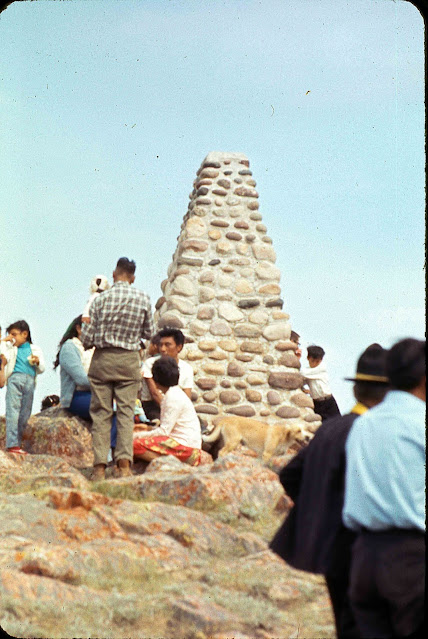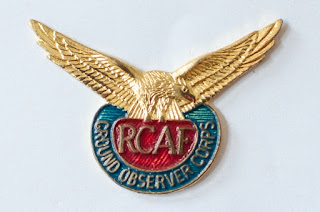We were to speak only English or French at the
Sacred Heart Residential School in Fort Providence, which I attended as a day
student from 1954 until 1958. It was forbidden for any of us to speak Indian. I
didn’t have a problem with this, as we only spoke English at home and, frankly,
never gave it much thought. I only knew that the kids that were caught talking
in Slavey, Loucheaux or Dogrib were being "bad", and would be punished by one of
the Sisters or Brothers. One warm June afternoon in 1955 my sister and I were
playing in the icehouse, and started babbling incoherently to each other,
laughing and shouting while acting out imaginary scenes. She was four years
younger, and still had a limited vocabulary, so it was fun making up words and
sounds, pretending to communicate. The game regressed into her chasing me
around the yard, onto the sidewalk and around the corner of the house, right
into Mike, my dad, who was painting the red screen door. “What are you doing,
talking like a goddamn Indian? Smarten up,” he blustered, “And watch out for
the wet paint.” The tone of his voice, the reminder of the school rule, and the
underlying fear of him stung like being slapped. We quietly went into the house
and Mom gave us a glass of water. The next week my grade one classmates shared
their excitement at going home for the summer, being with their parents, grandparents,
aunts and uncles, and talking Indian.
When
I Go Home I’m Going To Talk Indian
My best friend, Rose, was the most fun in
the world. I looked forward each day to meeting her in the school hallway just
before the bell rang. She often wore a barely-suppressed grin, or covered her
mouth with her hand. I would spend recess trying to get her tell me what the
joke was. Usually, she had managed undetected to plant a stone on Sister's chair
or sneak an extra crust of bread from the supper hall. Rose, head bobbing, dark
eyes twinkling, would finally share her secret transgression with me, causing
us both to burst into uncontrollable giggles, and occasionally drawing the
attention of a stony-faced nun who, disturbed by our laughter, would shoo us to
move on.
The Catholic Mission loomed at the far end
of the only road cutting through Fort Providence, Northwest Territories. In
l954, I entered my first year of school there as the only "white
kid". My father spent his days predicting weather and tapping it in Morse code,
down to a military base in Hay River. My mother cooked, knitted, sewed my
clothes and preserved berries. I, being a spirited 5 year old, knew that we
lived in an exciting place, accessible only by barge or float plane and snowed
under nine months of the year.
The Mission school was the place for me to
go to and hang out with other children. I didn't question the locked iron
doors, the bars on the windows, the unreasonable rules imposed by the nuns. I
didn't find it unusual that my playmates were several hundred native children
who lived at the school rather than with their families. It was my only
experience of school and I had no need to question.
The day I arrived at school and didn't see
Rose, I thought she must be ill. The recess bell finally rang and, in the
impish manner I had learned from my friend, I quietly slid down the forbidding
corridors that led to the dormitory. The nun who was changing the beds glared
at me as though I wasn't meant to exist. I lowered my eyes to my shoes, knowing
the necessary rules to avoid having to stand in the corner or get the strap.
"What are you doing here?" she
barked.
I heard the squeak of her black boots, the
jangle of her crucifix and the angry swish of her robes as she came closer.
"Looking for Rose, Sister. I thought
she was sick." "She's not here. Now get back to class!"
I scurried back to the coatroom and pulled
on my parka and touque.
She must be outside, I thought, struggling to
push open the heavy back door.
Children filled the snowy yard, screaming,
laughing, building snow forts and pulling each other around on little pieces of
cardboard. It was freezing today and the nuns gathered close to the building,
warming their hands over the fire barrel. I stood on the high stone steps,
searching everywhere for Rose's red jacket. Finally I spotted her in the
farthest corner, standing with her face to the fence, no friends around.
"Rose!"
I shouted as loudly as I could, running
down the steps and slogging through the deepest part of the snow where the
other children had not gone. When I reached her, I tugged on her sleeve.
"Come on, Rose! Recess is almost
over!"
She kept her back to me, warming her hands
under her jacket. Impatiently, I tugged again, sure that the bell would ring at
any moment and we would have no time to play.
Now she turned, her face drawn with pain
and fury. She held up her red, swollen hands and I knew then that she hadn't
been warming them, but holding, protecting them as best she could, from the
searing pain. I saw the tears, which had frozen on her beautiful cheeks.
"When I go home I'm going to talk
Indian!", she whispered fiercely.
The bell rang and neither one of us moved.
Cold needled into our faces and I stood, watching Rose breathe rapid frosty
puffs into the bleak northern air. I didn't know what to do for my friend. When
I looked back, I saw the other children were almost all inside.
"Rose, we have to go."
She nodded, wiping her face in her sleeve.
We couldn't hold hands like we usually did. Instead, I touched her shoulder as
we walked toward the stone steps, where two nuns stood like sentries, waiting
for us.
Rose and I never talked about what had
happened to her. We still sat together everyday and traded the ribbons in our
hair. We built forts and pulled each other around in the snow on pieces of
cardboard. Rose talked longingly of eating her granny's toasted bannock and
romping in the woods with her younger sisters, who hadn't yet arrived at the Mission
school.
Our family left Fort Providence two years
later. In the time I knew her, Rose never did get to go home.
Copyright
© Carol M. Hodgson, March 2000 All Rights Reserved
[Note from Sonja Keohane: After reading
this, I asked Carol for an explanation of what had been done to Rose's hands.
This was her response:
Rose was strapped for speaking her
language. This is a common practice in schools all over the place at the time.
Her open hands were hit with a large thick leather strap, many times. I received
the strap on several occasions, although not as harshly as Rose did in my
story. I did see many native children whose hands were strapped so long and
hard that they were blistered for days, as though they had been burned with
fire.]
 |
| Carol and I at my birthday party in March 1955. |
 |
| Me, my sister Tania and Carol on Hallowe'en, probably 1955, at Carol's house in the Army Signals compound. |





















































